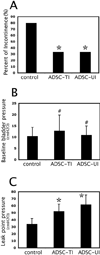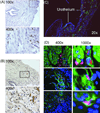Treatment of stress urinary incontinence with adipose tissue-derived stem cells
- PMID: 19878076
- PMCID: PMC2871776
- DOI: 10.3109/14653240903350265
Treatment of stress urinary incontinence with adipose tissue-derived stem cells
Abstract
Background aims: Effective treatment for stress urinary incontinence (SUI) is lacking. This study investigated whether transplantation of adipose tissue-derived stem cells (ADSC) can treat SUI in a rat model.
Methods: Rats were induced to develop SUI by postpartum vaginal balloon dilation and bilateral ovariectomy. ADSC were isolated from the peri-ovary fat, examined for stem cell properties, and labeled with thymidine analog BrdU or EdU. Ten rats received urethral injection of saline as a control. Twelve rats received urethral injection of EdU-labeled ADSC and six rats received intravenous injection of BrdU-labeled ADSC through the tail vein. Four weeks later, urinary voiding function was assessed by conscious cystometry. The rats were then killed and their urethras harvested for tracking of ADSC and quantification of elastin, collagen and smooth muscle contents.
Results: Cystometric analysis showed that eight out 10 rats in the control group had abnormal voiding, whereas four of 12 (33.3%) and two of six (33.3%) rats in the urethra-ADSC and tail vein-ADSC groups, respectively, had abnormal voiding. Histologic analysis showed that the ADSC-treated groups had significantly higher elastin content than the control group and, within the ADSC-treated groups, rats with normal voiding pattern also had significantly higher elastin content than rats with voiding dysfunction. ADSC-treated normal-voiding rats had significantly higher smooth muscle content than control or ADSC-treated rats with voiding dysfunction.
Conclusions: Transplantation of ADSC via urethral or intravenous injection is effective in the treatment and/or prevention of SUI in a pre-clinical setting.
Figures





References
-
- Norton P, Brubaker L. Urinary incontinence in women. Lancet. 2006;367:57–67. - PubMed
-
- Hu TW, Wagner TH, Bentkover JD, Leblanc K, Zhou SZ, Hunt T. Costs of urinary incontinence and overactive bladder in the United States: a comparative study. Urology. 2004;63:461–465. - PubMed
-
- Gibbs CF, Johnson TM, 2nd, Ouslander JG. Office management of geriatric urinary incontinence. Am J Med. 2007;120:211–220. - PubMed
-
- Dooley Y, Kenton K, Cao G, Luke A, Durazo-Arvizu R, Kramer H, et al. Urinary Incontinence Prevalence: Results From the National Health and Nutrition Examination Survey. J Urol. 2007 - PubMed
-
- Albo ME, Richter HE, Brubaker L, Norton P, Kraus SR, Zimmern PE, et al. Burch colposuspension versus fascial sling to reduce urinary stress incontinence. N Engl J Med. 2007;356:2143–2155. - PubMed
Publication types
MeSH terms
Substances
Grants and funding
LinkOut - more resources
Full Text Sources
Other Literature Sources
Medical

